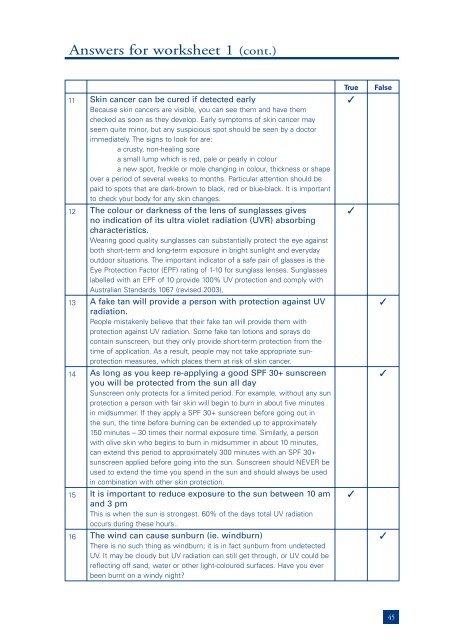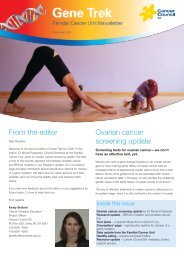Be SunSmart final print file.indd - Cancer Council SA
Be SunSmart final print file.indd - Cancer Council SA
Be SunSmart final print file.indd - Cancer Council SA
You also want an ePaper? Increase the reach of your titles
YUMPU automatically turns print PDFs into web optimized ePapers that Google loves.
Answers for worksheet 1 (cont.)<br />
11<br />
12<br />
13<br />
14<br />
15<br />
16<br />
Skin cancer can be cured if detected early<br />
<strong>Be</strong>cause skin cancers are visible, you can see them and have them<br />
checked as soon as they develop. Early symptoms of skin cancer may<br />
seem quite minor, but any suspicious spot should be seen by a doctor<br />
immediately. The signs to look for are:<br />
a crusty, non-healing sore<br />
a small lump which is red, pale or pearly in colour<br />
a new spot, freckle or mole changing in colour, thickness or shape<br />
over a period of several weeks to months. Particular attention should be<br />
paid to spots that are dark-brown to black, red or blue-black. It is important<br />
to check your body for any skin changes.<br />
The colour or darkness of the lens of sunglasses gives<br />
no indication of its ultra violet radiation (UVR) absorbing<br />
characteristics.<br />
Wearing good quality sunglasses can substantially protect the eye against<br />
both short-term and long-term exposure in bright sunlight and everyday<br />
outdoor situations. The important indicator of a safe pair of glasses is the<br />
Eye Protection Factor (EPF) rating of 1-10 for sunglass lenses. Sunglasses<br />
labelled with an EPF of 10 provide 100% UV protection and comply with<br />
Australian Standards 1067 (revised 2003).<br />
A fake tan will provide a person with protection against UV<br />
radiation.<br />
People mistakenly believe that their fake tan will provide them with<br />
protection against UV radiation. Some fake tan lotions and sprays do<br />
contain sunscreen, but they only provide short-term protection from the<br />
time of application. As a result, people may not take appropriate sunprotection<br />
measures, which places them at risk of skin cancer.<br />
As long as you keep re-applying a good SPF 30+ sunscreen<br />
you will be protected from the sun all day<br />
Sunscreen only protects for a limited period. For example, without any sun<br />
protection a person with fair skin will begin to burn in about five minutes<br />
in midsummer. If they apply a SPF 30+ sunscreen before going out in<br />
the sun, the time before burning can be extended up to approximately<br />
150 minutes – 30 times their normal exposure time. Similarly, a person<br />
with olive skin who begins to burn in midsummer in about 10 minutes,<br />
can extend this period to approximately 300 minutes with an SPF 30+<br />
sunscreen applied before going into the sun. Sunscreen should NEVER be<br />
used to extend the time you spend in the sun and should always be used<br />
in combination with other skin protection.<br />
It is important to reduce exposure to the sun between 10 am<br />
and 3 pm<br />
This is when the sun is strongest. 60% of the days total UV radiation<br />
occurs during these hours..<br />
The wind can cause sunburn (ie. windburn)<br />
There is no such thing as windburn; it is in fact sunburn from undetected<br />
UV. It may be cloudy but UV radiation can still get through, or UV could be<br />
reflecting off sand, water or other light-coloured surfaces. Have you ever<br />
been burnt on a windy night?<br />
True False<br />
3<br />
3<br />
3<br />
3<br />
3<br />
3<br />
45



